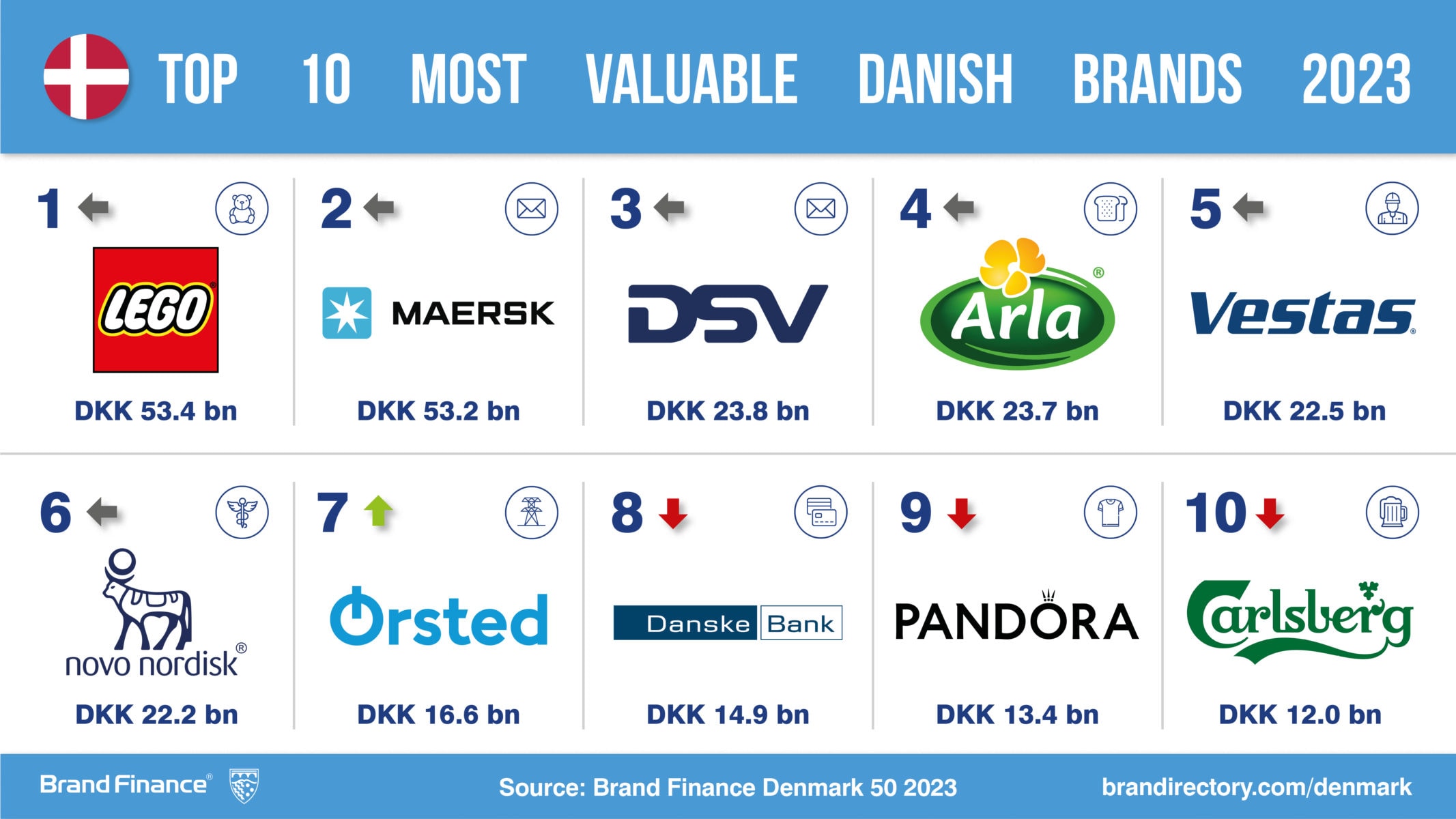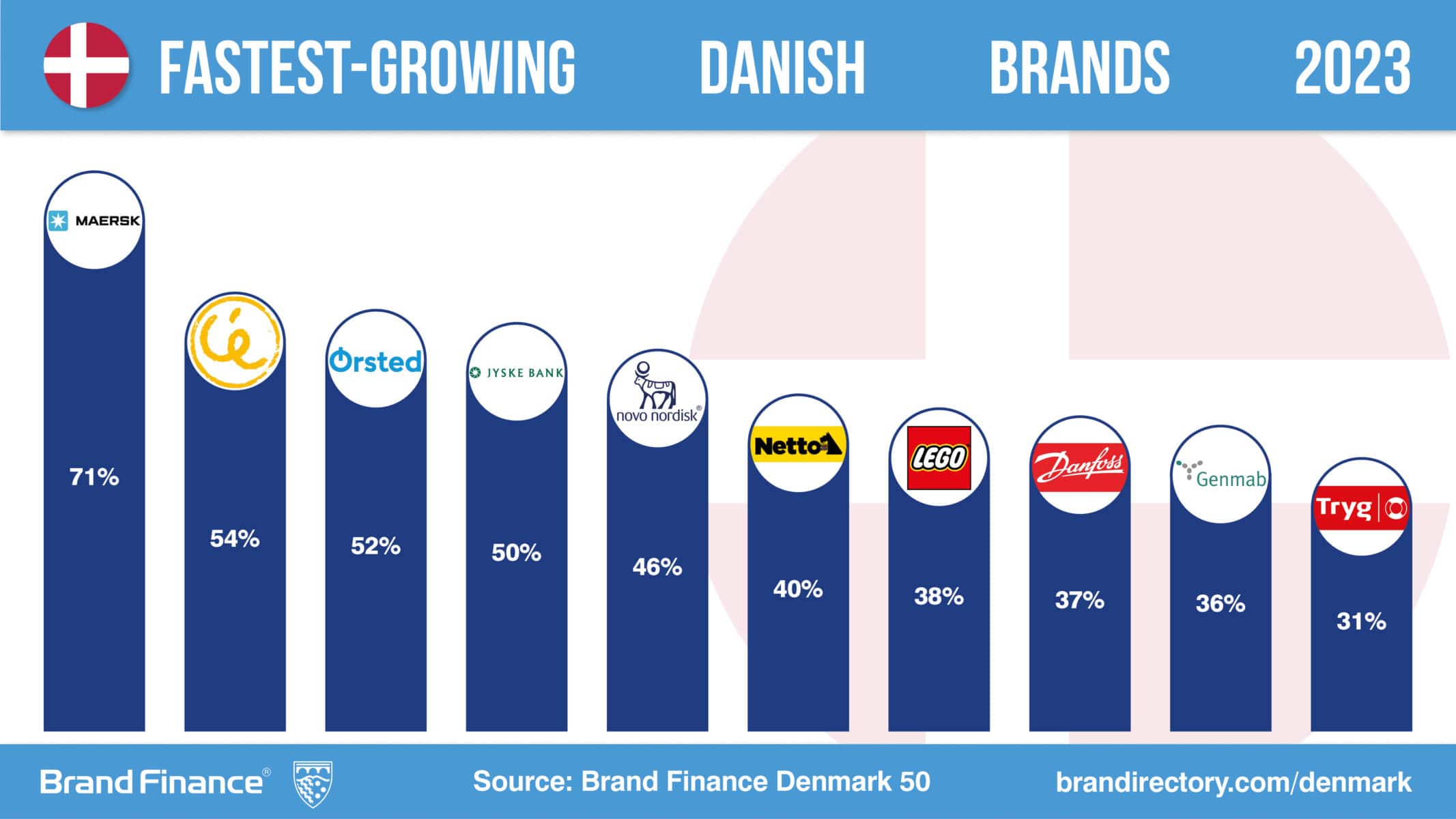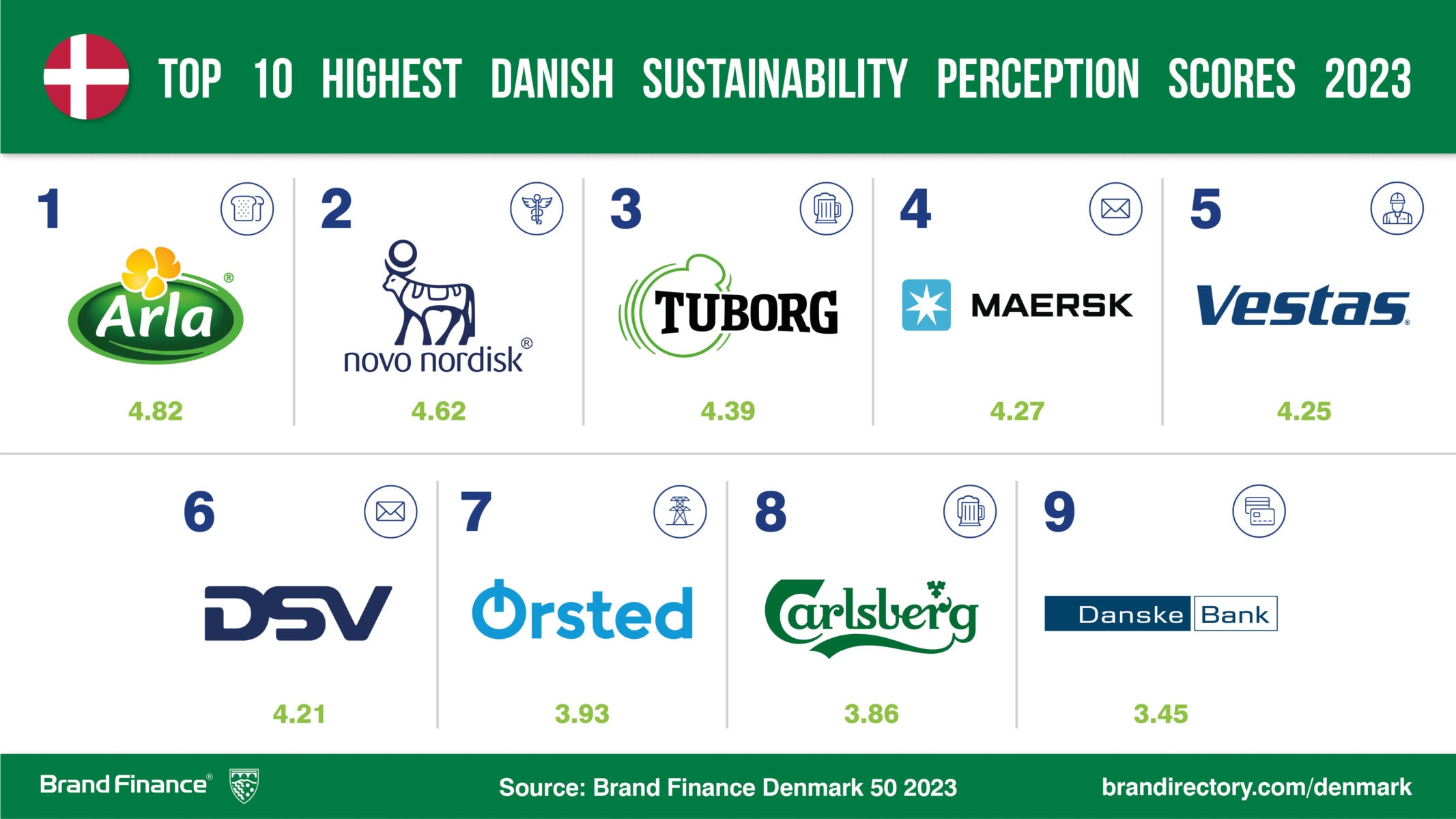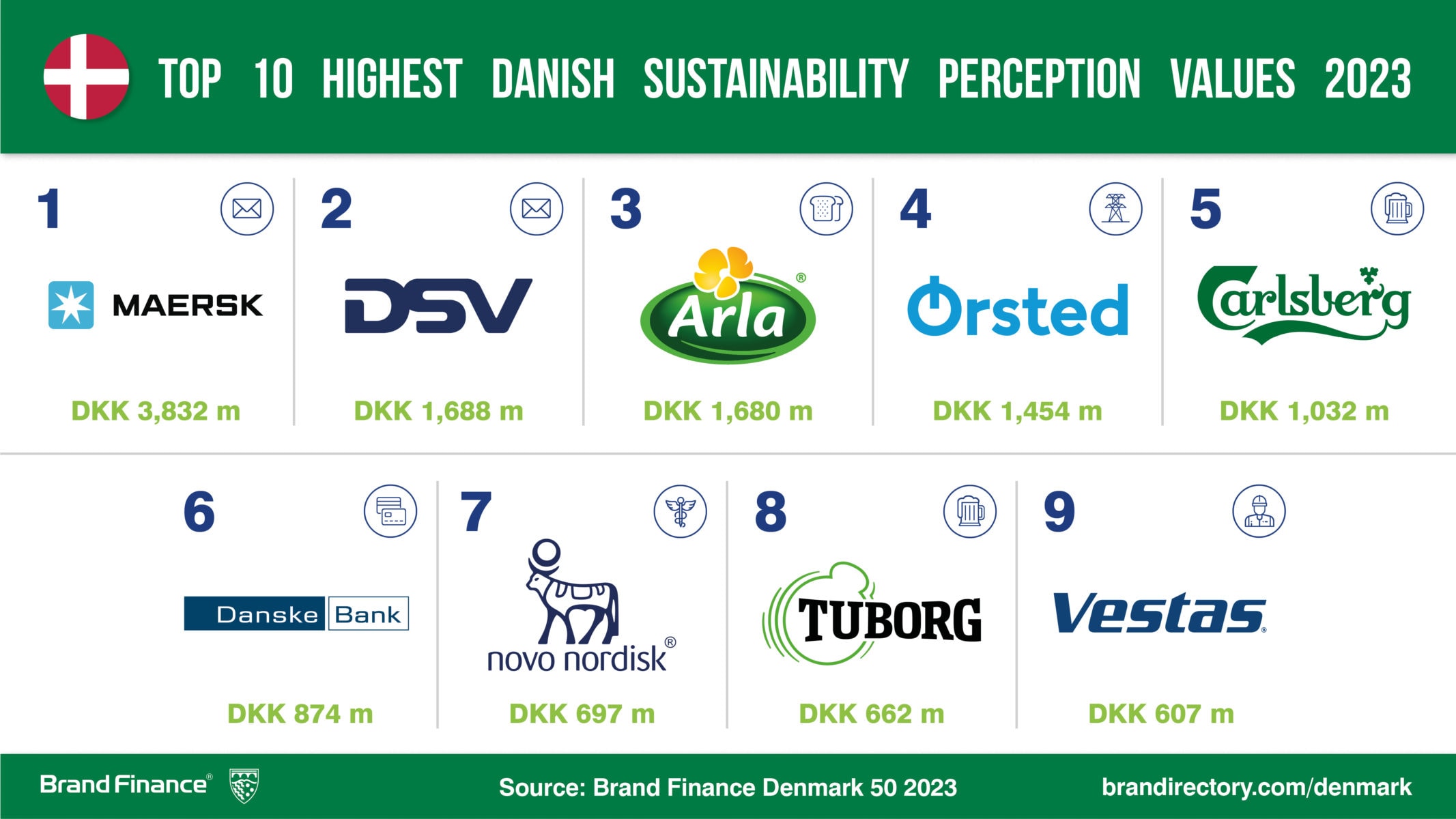View the full Brand Finance Denmark 50 2023 report here
Lego is Denmark’s most valuable brand for an eighth consecutive year. This came as Lego achieved a 38% year-on-year brand value increase to DKK53.4 billion. This also makes Lego the world’s most valuable toys brand.
Anna Brolin, Managing Director of Brand Finance Nordics commented:
“The biggest Danish brands are unusual for being firmly rooted in the physical world: Lego is an iconic brand across the world for the unlimited play opportunities it creates, and Maersk is an integral part of the global goods economy. Across the world, children know that a Lego toy represents hours of fun, while parents know the pain of standing on a forgotten Lego piece in the middle of the night. That is the value of Danish brands, which are enduring into the 21st century.”
In addition to calculating brand value, Brand Finance also determines the relative strength of brands through a balanced scorecard of metrics evaluating marketing investment, stakeholder equity, and business performance. In addition to being the most valuable brand, Lego is also the strongest brand in the ranking with a Brand Strength Index (BSI) score of 85.9 out of 100 and a corresponding AAA brand rating.

Globally-integrated logistics brand, Maersk, has achieved 71% year-on-year brand value growth, taking it to DKK53.2 billion, and reducing the gap behind Lego at the top of the ranking. Maersk has now more-than-doubled in brand value from its pre-pandemic level, with Maersk’s brand strength increasing to 75 with a corresponding AA+ rating.

Utilities brand Ørsted has jumped four places, following a brand value increase of 52% to DKK16.6 billion. This also makes it the third fastest growing Danish brand. In doing this it has leap-frogged Danske Bank (brand value up 5% to DKK14.9 billion), Pandora (brand value up 3% to DKK13.4 billion), and Carlsberg (brand value up 4% to DKK12 billion), all of which drop one position in the ranking.
Novo Nordisk (brand value up 46% to DKK22.2 billion) is a multinational pharmaceutical company specialising in diabetes and weight loss drugs. The brand’s forecasts have increased in 2023, tied to the active promotion and the ramping up of its production of weight loss drugs, Wegovy and Ozempic. These had previously faced widespread shortages last year due to its increasing popularity. Wegovy, also used to treat diabetes, is a once daily injection that suppresses appetite. Testing has found strong connections with weight loss, and as consumer awareness increases, the Novo Nordisk brand is likely to benefit in coming years.
Scandinavia’s largest producer of dairy products, Arla (brand value up 5% to DKK23.7 billion), has the highest Sustainability Perceptions Score of any brand included in the Denmark 50 2023 ranking – 4.82 out of 10. Its Sustainability Perceptions Value is DKK1.7 billion. This indicates the value that Arla has tied up in the sustainability perceptions of stakeholders.

As well as being Denmark’s second most valuable brand, Maersk also has the highest Sustainability Perception Value at DKK3.8 billion. The brand’s position at the top of the SPV table is not an assessment of its overall sustainability performance, but rather indicates how much brand value it has tied up in sustainability perceptions. Maersk’s Sustainability Perception Score was also 4.27 out of 10, the fourth highest in the ranking.

Denmark ranks 18 in the world in the Global Soft Power Index 2023. This means Denmark defends its rank position from last year, at the same time as the nation increases its total score. The nation continues to stand out in relation to several metrics and received a worldwide top 10 rank in three of the eight pillars that contribute to a nation’s Soft Power: “Governance” (ranked 10th), People & Values (ranked 8th) and “Sustainable Future” (ranked 9th), which proves that Denmark continues to punch above its weight in the Soft Power league.
ENDS
Brand Finance is the world’s leading brand valuation consultancy. Bridging the gap between marketing and finance, Brand Finance evaluates the strength of brands and quantifies their financial value to help organisations make strategic decisions.
Headquartered in London, Brand Finance operates in over 25 countries. Every year, Brand Finance conducts more than 6,000 brand valuations, supported by original market research, and publishes over 100 reports which rank brands across all sectors and countries.
Brand Finance also operates the Global Brand Equity Monitor, conducting original market research annually on 6,000 brands, surveying more than 175,000 respondents across 41 countries and 31 industry sectors. By combining perceptual data from the Global Brand Equity Monitor with data from its valuation database — the largest brand value database in the world — Brand Finance equips ambitious brand leaders with the data, analytics, and the strategic guidance they need to enhance brand and business value.
In addition to calculating brand value, Brand Finance also determines the relative strength of brands through a balanced scorecard of metrics evaluating marketing investment, stakeholder equity, and business performance, compliant with ISO 20671.
Brand Finance is a regulated accountancy firm and a committed leader in the standardisation of the brand valuation industry. Brand Finance was the first to be certified by independent auditors as compliant with both ISO 10668 and ISO 20671 and has received the official endorsement of the Marketing Accountability Standards Board (MASB) in the United States.
Brand is defined as a marketing-related intangible asset including, but not limited to, names, terms, signs, symbols, logos, and designs, intended to identify goods, services, or entities, creating distinctive images and associations in the minds of stakeholders, thereby generating economic benefits.
Brand strength is the efficacy of a brand’s performance on intangible measures relative to its competitors. Brand Finance evaluates brand strength in a process compliant with ISO 20671, looking at Marketing Investment, Stakeholder Equity, and the impact of those on Business Performance. The data used is derived from Brand Finance’s proprietary market research programme and from publicly available sources.
Each brand is assigned a Brand Strength Index (BSI) score out of 100, which feeds into the brand value calculation. Based on the score, each brand is assigned a corresponding Brand Rating up to AAA+ in a format similar to a credit rating.
Brand Finance calculates the values of brands in its rankings using the Royalty Relief approach – a brand valuation method compliant with the industry standards set in ISO 10668. It involves estimating the likely future revenues that are attributable to a brand by calculating a royalty rate that would be charged for its use, to arrive at a ‘brand value’ understood as a net economic benefit that a brand owner would achieve by licensing the brand in the open market.
The steps in this process are as follows:
1 Calculate brand strength using a balanced scorecard of metrics assessing Marketing Investment, Stakeholder Equity, and Business Performance. Brand strength is expressed as a Brand Strength Index (BSI) score on a scale of 0 to 100.
2 Determine royalty range for each industry, reflecting the importance of brand to purchasing decisions. In luxury, the maximum percentage is high, while in extractive industry, where goods are often commoditised, it is lower. This is done by reviewing comparable licensing agreements sourced from Brand Finance’s extensive database.
3 Calculate royalty rate. The BSI score is applied to the royalty range to arrive at a royalty rate. For example, if the royalty range in a sector is 0-5% and a brand has a BSI score of 80 out of 100, then an appropriate royalty rate for the use of this brand in the given sector will be 4%.
4 Determine brand-specific revenues by estimating a proportion of parent company revenues attributable to a brand.
5 Determine forecast revenues using a function of historic revenues, equity analyst forecasts, and economic growth rates.
6 Apply the royalty rate to the forecast revenues to derive brand revenues.
7 Discount post-tax brand revenues to a net present value which equals the brand value.
Brand Finance has produced this study with an independent and unbiased analysis. The values derived and opinions presented in this study are based on publicly available information and certain assumptions that Brand Finance used where such data was deficient or unclear. Brand Finance accepts no responsibility and will not be liable in the event that the publicly available information relied upon is subsequently found to be inaccurate. The opinions and financial analysis expressed in the study are not to be construed as providing investment or business advice. Brand Finance does not intend the study to be relied upon for any reason and excludes all liability to any body, government, or organisation.
The data presented in this study form part of Brand Finance's proprietary database, are provided for the benefit of the media, and are not to be used in part or in full for any commercial or technical purpose without written permission from Brand Finance.